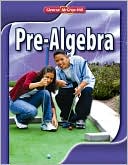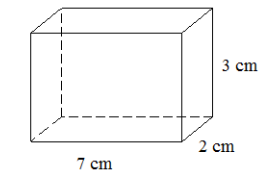
(a)
To find: the volume of the figure
(a)
Answer to Problem 27PPS
The volume of the rectangular box is
Explanation of Solution
Given:
Consider the figure

Formula used:
The volume V of the rectangular box is
Calculation:
The objective is to find the volume of the figure.
The volume V of the rectangular box is given by the formula
Where l is the length, w is the width and h is the height of the rectangular box.
Put
Thus, the volume V is
Conclusion:
Therefore, the volume of the rectangular box is
(b)
To explain:the volume change if one of the dimensions is doubled.
(b)
Answer to Problem 27PPS
Therefore, when three of the dimensions are doubled then the new volume is also 8 times the old volume.
Explanation of Solution
Calculation:
The objective is to find the change in volume when one of the dimensions is doubled.
Let length l is doubled. Let the new volume is
Thus, the new volume
When one of the dimensions is doubled then the new volume is also doubled.
The objective is to find the change in volume when two of the dimensions are doubled.
Let l length and width w is doubled. Let the new volume is
Thus, the new volume
When two of the dimensions are doubled then the new volume is also 4 times the old volume.
The objective is to find the change in volume when three of the dimensions are doubled.
Let length l , width w and height h is doubled. Let the new volume is
Thus, the new volume
When three of the dimensions are doubled then the new volume is also 8 times the old volume
Conclusion:
Therefore, when three of the dimensions are doubled then the new volume is also 8 times the old volume.
(c)
To discuss: the repeat above steps and triple each dimension.
(c)
Answer to Problem 27PPS
When three of the dimensions are triple then the new volume is also 27 times the old volume.
Explanation of Solution
Calculation:
The objective is to find the change in volume when one of the dimensions is triple.
Let lengthl is triple. Let the new volume is
Thus, the new volume
When one of the dimensions is triple then the new volume is also triple.
The objective is to find the change in volume when two of the dimensions are triple.
Let length l and width w is triple. Let the new volume is
Thus, the new volume
When two of the dimensions are triple then the new volume is also 9 times the old volume
The objective is to find the change in volume when three of the dimensions are triple.
Let length l width w and heighth his triple. Let the new volume is
Thus, the new volume
When three of the dimensions are triple then the new volume is also 27 times the old volume.
Conclusion:
Therefore,when three of the dimensions are triple then the new volume is also 27 times the old volume.
(d)
To discuss: the repeat above steps and triple each dimension.
(d)
Answer to Problem 27PPS
When each of the dimensions is multiplied by 6 then the new volume is also 216 times the old volume.
Explanation of Solution
Calculation:
The objective is to find the change in volume when each of the dimensions are multiplied by 6. Let length l , width w and height h his multiplied by 6. Let the new volume is
Thus, the new volume
When each of the dimensions is multiplied by 6 then the new volume is also 216 times the old volume.
Conclusion:
Therefore,when each of the dimensions is multiplied by 6 then the new volume is also 216 times the old volume.
Chapter 12 Solutions
Pre-Algebra, Student Edition
Additional Math Textbook Solutions
College Algebra (7th Edition)
A Problem Solving Approach To Mathematics For Elementary School Teachers (13th Edition)
Intro Stats, Books a la Carte Edition (5th Edition)
Elementary Statistics
Thinking Mathematically (6th Edition)
Basic Business Statistics, Student Value Edition
- Please use the infinite series formula and specify how you did each step. Thank you.arrow_forward8) Solve the given system using the Gaussian Elimination process. 2x8y = 3 (-6x+24y = −6arrow_forward7) Solve the given system using the Gaussian Elimination process. (5x-4y = 34 (2x - 2y = 14arrow_forward
- 33 (a) (b) Let A(t) = = et 0 0 0 cos(t) sin(t) 0-sin(t) cos(t)) For any fixed tЄR, find det(A(t)). Show that the matrix A(t) is invertible for any tЄ R, and find the inverse (A(t))¹.arrow_forwardUse the infinite geometric sum to convert .258 (the 58 is recurring, so there is a bar over it) to a ratio of two integers. Please go over the full problem, specifying how you found r. Thank you.arrow_forwardH.w: Find the Eigen vectors for the largest Eigen value of the system X1+ +2x3=0 3x1-2x2+x3=0 4x1+ +3x3=0arrow_forward
- need help with 5 and 6 pleasearrow_forward1) Given matrix A below, answer the following questions: a) What is the order of the matrix? b) What is the element a13? c) What is the element a₁₁? 4 -1arrow_forward[25 points] Given the vector let v = ER² and the collection of vectors ε = E-{)·()}-{☹) (9)} = {(A)·(9)}· B: = and C = · {(6)·(})}· answer the following question. (a) (b) (c) (d) (e) verify Verify is a basis for R² and find the coordinate [] of under ε. Verify B is a basis for R2 and find the coordinate []B of ʊ Verify C is a basis for R2 and find the coordinate []c of under ε. under ε. Find the change-of-basis matrix [I]+B from basis B to basis ε, and EE+BUB Find the change-of-basis matrix [I]B+ε from basis Ɛ to basis B, and verify [U]B= [] B+EVEarrow_forward
- Explain the following terms | (a) linear span (b) dimension of vector space (c) linearly independent (d) linearly dependent (e) rank of matrix Aarrow_forward3. Let u = 3/5 √ = and = -4/5 -() Define V span{ū, }. (a) (b) (c) Show that {u, } is orthonormal and forms a basis for V. Explicitly compute Projy w. Explicitly give a non-zero vector in V+.arrow_forwardIs 1.1 0.65 -3.4 0.23 0.4 -0.44 a basis for R3? You must explain your answer 0arrow_forward
 Algebra and Trigonometry (6th Edition)AlgebraISBN:9780134463216Author:Robert F. BlitzerPublisher:PEARSON
Algebra and Trigonometry (6th Edition)AlgebraISBN:9780134463216Author:Robert F. BlitzerPublisher:PEARSON Contemporary Abstract AlgebraAlgebraISBN:9781305657960Author:Joseph GallianPublisher:Cengage Learning
Contemporary Abstract AlgebraAlgebraISBN:9781305657960Author:Joseph GallianPublisher:Cengage Learning Linear Algebra: A Modern IntroductionAlgebraISBN:9781285463247Author:David PoolePublisher:Cengage Learning
Linear Algebra: A Modern IntroductionAlgebraISBN:9781285463247Author:David PoolePublisher:Cengage Learning Algebra And Trigonometry (11th Edition)AlgebraISBN:9780135163078Author:Michael SullivanPublisher:PEARSON
Algebra And Trigonometry (11th Edition)AlgebraISBN:9780135163078Author:Michael SullivanPublisher:PEARSON Introduction to Linear Algebra, Fifth EditionAlgebraISBN:9780980232776Author:Gilbert StrangPublisher:Wellesley-Cambridge Press
Introduction to Linear Algebra, Fifth EditionAlgebraISBN:9780980232776Author:Gilbert StrangPublisher:Wellesley-Cambridge Press College Algebra (Collegiate Math)AlgebraISBN:9780077836344Author:Julie Miller, Donna GerkenPublisher:McGraw-Hill Education
College Algebra (Collegiate Math)AlgebraISBN:9780077836344Author:Julie Miller, Donna GerkenPublisher:McGraw-Hill Education





